Measuring the Demand Connectedness among China’s Regional Carbon Markets
Abstract
1. Introduction
2. Literature Review
2.1. Benefit and Risk of Emission-Trading Policy
2.2. Connectedness of Emission-Trading Markets
2.3. Review Summary
3. Methodology and Data
3.1. Frequency Connectedness Measure
3.2. Data and Preliminary Analysis
4. Empirical Analysis
4.1. Connectedness in Time Domain
4.2. Connectedness in Frequency Domain
4.3. Sensitivity Analysis
5. Conclusions
6. Implications
Author Contributions
Funding
Institutional Review Board Statement
Informed Consent Statement
Data Availability Statement
Conflicts of Interest
References
- Van Soest, H.L.; den Elzen MG, J.; van Vuuren, D.P. Net-zero emission targets for major emitting countries consistent with the Paris Agreement. Nat. Commun. 2021, 12, 2140. [Google Scholar] [CrossRef] [PubMed]
- Duan, H.; Zhou, S.; Jiang, K.; Bertram, C.; Harmsen, M.; Kriegler, E.; Edmonds, J. Assessing China’s efforts to pursue the 1.5 °C warming limit. Science 2021, 372, 378–385. [Google Scholar] [CrossRef] [PubMed]
- Yang, J.; Hao, Y.; Feng, C. A race between economic growth and carbon emissions: What play important roles towards global low-carbon development? Energy Econ. 2021, 100, 105327. [Google Scholar] [CrossRef]
- Ehlers, T.; Packer, F.; de Greiff, K. The pricing of carbon risk in syndicated loans: Which risks are priced and why? J. Bank. Finance 2022, 136, 106180. [Google Scholar] [CrossRef]
- Zhang, D.; Zhang, Q.; Qi, S.; Huang, J.; Karplus, V.J.; Zhang, X. Integrity of firms’ emissions reporting in China’s early carbon markets. Nat. Clim. Chang. 2019, 9, 164–169. [Google Scholar] [CrossRef]
- Zhang, W.; Li, J.; Li, G.; Guo, S. Emission reduction effect and carbon market efficiency of carbon emissions trading policy in China. Energy 2020, 196, 117117. [Google Scholar] [CrossRef]
- Kim, P.; Bae, H. Do firms respond differently to the carbon pricing by industrial sector? How and why? A comparison between manufacturing and electricity generation sectors using firm-level panel data in Korea. Energy Policy 2022, 162, 112773. [Google Scholar] [CrossRef]
- Xia, X.; Li, M.; Li, B.; Wang, H. The Impact of Carbon Trade on Outsourcing Remanufacturing. Int. J. Environ. Res. Public Health 2021, 18, 10804. [Google Scholar] [CrossRef]
- Xuan, D.; Ma, X.; Shang, Y. Can China’s policy of carbon emission trading promote carbon emission reduction? J. Clean Prod. 2020, 270, 122383. [Google Scholar] [CrossRef]
- Guo, J.; Gu, F.; Liu, Y.; Liang, X.; Mo, J.; Fan, Y. Assessing the impact of ETS trading profit on emission abatements based on firm-level transactions. Nat. Commun. 2020, 11, 2078. [Google Scholar] [CrossRef] [PubMed]
- Bayer, P.; Aklin, M. The European Union Emissions Trading System reduced CO 2 emissions despite low prices. Proc. Natl. Acad. Sci. USA 2020, 117, 8804–8812. [Google Scholar] [CrossRef] [PubMed]
- Zhu, J.; Fan, Y.; Deng, X.; Xue, L. Low-carbon innovation induced by emissions trading in China. Nat. Commun. 2019, 10, 4088. [Google Scholar] [CrossRef]
- Liu, Z.; Sun, H. Assessing the impact of emissions trading scheme on low-carbon technological innovation: Evidence from China. Environ. Impact Assess. Rev. 2021, 89, 106589. [Google Scholar] [CrossRef]
- Chen, Z.; Zhang, X.; Chen, F. Do carbon emission trading schemes stimulate green innovation in enterprises? Evidence from China. Technol. Forecast. Soc. Chang. 2021, 168, 120744. [Google Scholar] [CrossRef]
- Wang, S.; Chen, G.; Han, X. An Analysis of the Impact of the Emissions Trading System on the Green Total Factor Productivity Based on the Spatial Difference-in-Differences Approach: The Case of China. Int. J. Environ. Res. Public Health 2021, 18, 9040. [Google Scholar] [CrossRef]
- Luo, Y.; Li, X.; Qi, X.; Zhao, D. The impact of emission trading schemes on firm competitiveness: Evidence of the mediating effects of firm behaviors from the guangdong ETS. J. Environ. Manag. 2021, 290, 112633. [Google Scholar] [CrossRef]
- Zhang, Y.-J.; Wang, W. How does China’s carbon emissions trading (CET) policy affect the investment of CET-covered en-terprises? Energy Econ. 2021, 98, 105224. [Google Scholar] [CrossRef]
- Wen, F.; Wu, N.; Gong, X. China’s carbon emissions trading and stock returns. Energy Econ. 2020, 86, 104627. [Google Scholar] [CrossRef]
- Chang, K.; Ge, F.; Zhang, C.; Wang, W. The dynamic linkage effect between energy and emissions allowances price for regional emissions trading scheme pilots in China. Renew. Sustain. Energy Rev. 2018, 98, 415–425. [Google Scholar] [CrossRef]
- Balcılar, M.; Demirer, R.; Hammoudeh, S.; Nguyen, D.K. Risk spillovers across the energy and carbon markets and hedging strategies for carbon risk. Energy Econ. 2016, 54, 159–172. [Google Scholar] [CrossRef]
- Tian, Y.; Akimov, A.; Roca, E.; Wong, V. Does the carbon market help or hurt the stock price of electricity companies? Further evidence from the European context. J. Clean. Prod. 2016, 112, 1619–1626. [Google Scholar] [CrossRef]
- Ji, Q.; Zhang, D.; Geng, J.-B. Information linkage, dynamic spillovers in prices and volatility between the carbon and energy markets. J. Clean. Prod. 2018, 198, 972–978. [Google Scholar] [CrossRef]
- Tan, X.; Sirichand, K.; Vivian, A.; Wang, X. How connected is the carbon market to energy and financial markets? A systematic analysis of spillovers and dynamics. Energy Econ. 2020, 90, 104870. [Google Scholar] [CrossRef]
- Kumar, S.; Managi, S.; Matsuda, A. Stock prices of clean energy firms, oil and carbon markets: A vector autoregressive analysis. Energy Econ. 2012, 34, 215–226. [Google Scholar] [CrossRef]
- Moreno, B.; García-Álvarez, M.T.; Fonseca, A.R. Fuel prices impacts on stock market of metallurgical industry under the EU emissions trading system. Energy 2017, 125, 223–233. [Google Scholar] [CrossRef]
- Zhao, L.; Wen, F.; Wang, X. Interaction among China carbon emission trading markets: Nonlinear Granger causality and time-varying effect. Energy Econ. 2020, 91, 104901. [Google Scholar] [CrossRef]
- Zhu, B.; Zhou, X.; Liu, X.; Wang, H.; He, K.; Wang, P. Exploring the risk spillover effects among China’s pilot carbon markets: A regular vine copula-CoES approach. J. Clean. Prod. 2020, 242, 118455. [Google Scholar] [CrossRef]
- Zhang, F.; Zhang, Z. The tail dependence of the carbon markets: The implication of portfolio management. PLoS ONE 2020, 15, e0238033. [Google Scholar] [CrossRef]
- Guo, L.Y.; Feng, C. Are there spillovers among China’s pilots for carbon emission allowances trading? Energy Econ. 2021, 103, 105574. [Google Scholar] [CrossRef]
- Xiao, Z.; Ma, S.; Sun, H.; Ren, J.; Feng, C.; Cui, S. Time-varying spillovers among pilot carbon emission trading markets in China. Environ. Sci. Pollut. Res. 2022, 29, 57421–57436. [Google Scholar] [CrossRef]
- Liu, X.; Zhou, X.; Zhu, B.; Wang, P. Measuring the efficiency of China’s carbon market: A comparison between efficient and fractal market hypotheses. J. Clean. Prod. 2020, 271, 122885. [Google Scholar] [CrossRef]
- Wu, R.; Qin, Z. Assessing market efficiency and liquidity: Evidence from China’s emissions trading scheme pilots. Sci. Total. Environ. 2021, 769, 144707. [Google Scholar] [CrossRef] [PubMed]
- Shen, W.; Wang, Y. Adaptive policy innovations and the construction of emission trading schemes in China: Taking stock and looking forward. Environ. Innov. Soc. Transit. 2019, 30, 59–68. [Google Scholar] [CrossRef]
- Chang, K.; Ye, Z.; Wang, W. Volatility spillover effect and dynamic correlation between regional emissions allowances and fossil energy markets: New evidence from China’s emissions trading scheme pilots. Energy 2019, 185, 1314–1324. [Google Scholar] [CrossRef]
- Chai, S.; Yang, X.; Zhang, Z.; Abedin, M.Z.; Lucey, B. Regional imbalances of market efficiency in China’s pilot emission trading schemes (ETS): A multifractal perspective. Res. Int. Bus. Finance 2022, 63, 101758. [Google Scholar] [CrossRef]
- Diebold, F.X.; Yilmaz, K. Better to give than to receive: Predictive directional measurement of volatility spillovers. Int. J. Forecast. 2012, 28, 57–66. [Google Scholar] [CrossRef]
- Diebold, F.X.; Yılmaz, K. Financial and Macroeconomic Connectedness: A Network Approach to Measurement and Monitoring; Oxford University Press: Oxford, UK, 2015. [Google Scholar]
- Maghyereh, A.I.; Awartani, B.; Bouri, E. The directional volatility connectedness between crude oil and equity markets: New evidence from implied volatility indexes. Energy Econ. 2016, 57, 78–93. [Google Scholar] [CrossRef]
- Tsouknidis, D.A. Dynamic volatility spillovers across shipping freight markets. Transp. Res. Part E Logist. Transp. Rev. 2016, 91, 90–111. [Google Scholar] [CrossRef]
- Wang, G.-J.; Xie, C.; Zhao, L.; Jiang, Z.-Q. Volatility connectedness in the Chinese banking system: Do state-owned commercial banks contribute more? J. Int. Financ. Mark. Inst. Money 2018, 57, 205–230. [Google Scholar] [CrossRef]
- Baruník, J.; Křehlík, T. Measuring the Frequency Dynamics of Financial Connectedness and Systemic Risk. J. Financ. Econ. 2018, 16, 271–296. [Google Scholar] [CrossRef]
- Ferrer, R.; Shahzad, S.J.H.; López, R.; Jareño, F. Time and frequency dynamics of connectedness between renewable energy stocks and crude oil prices. Energy Econ. 2018, 76, 1–20. [Google Scholar] [CrossRef]
- Kang, S.H.; Tiwari, A.K.; Albulescu, C.T.; Yoon, S.-M. Exploring the time-frequency connectedness and network among crude oil and agriculture commodities V1. Energy Econ. 2019, 84, 104543. [Google Scholar] [CrossRef]
- Lovcha, Y.; Perez-Laborda, A. Dynamic frequency connectedness between oil and natural gas volatilities. Econ. Model. 2020, 84, 181–189. [Google Scholar] [CrossRef]
- Tiwari, A.K.; Nasreen, S.; Shahbaz, M.; Hammoudeh, S. Time-frequency causality and connectedness between international prices of energy, food, industry, agriculture and metals. Energy Econ. 2019, 85, 104529. [Google Scholar] [CrossRef]
- Koop, G.; Pesaran, M.; Potter, S.M. Impulse response analysis in nonlinear multivariate models. J. Econ. 1996, 74, 119–147. [Google Scholar] [CrossRef]
- Pesaran, H.; Shin, Y. Generalized impulse response analysis in linear multivariate models. Econ. Lett. 1998, 58, 17–29. [Google Scholar] [CrossRef]
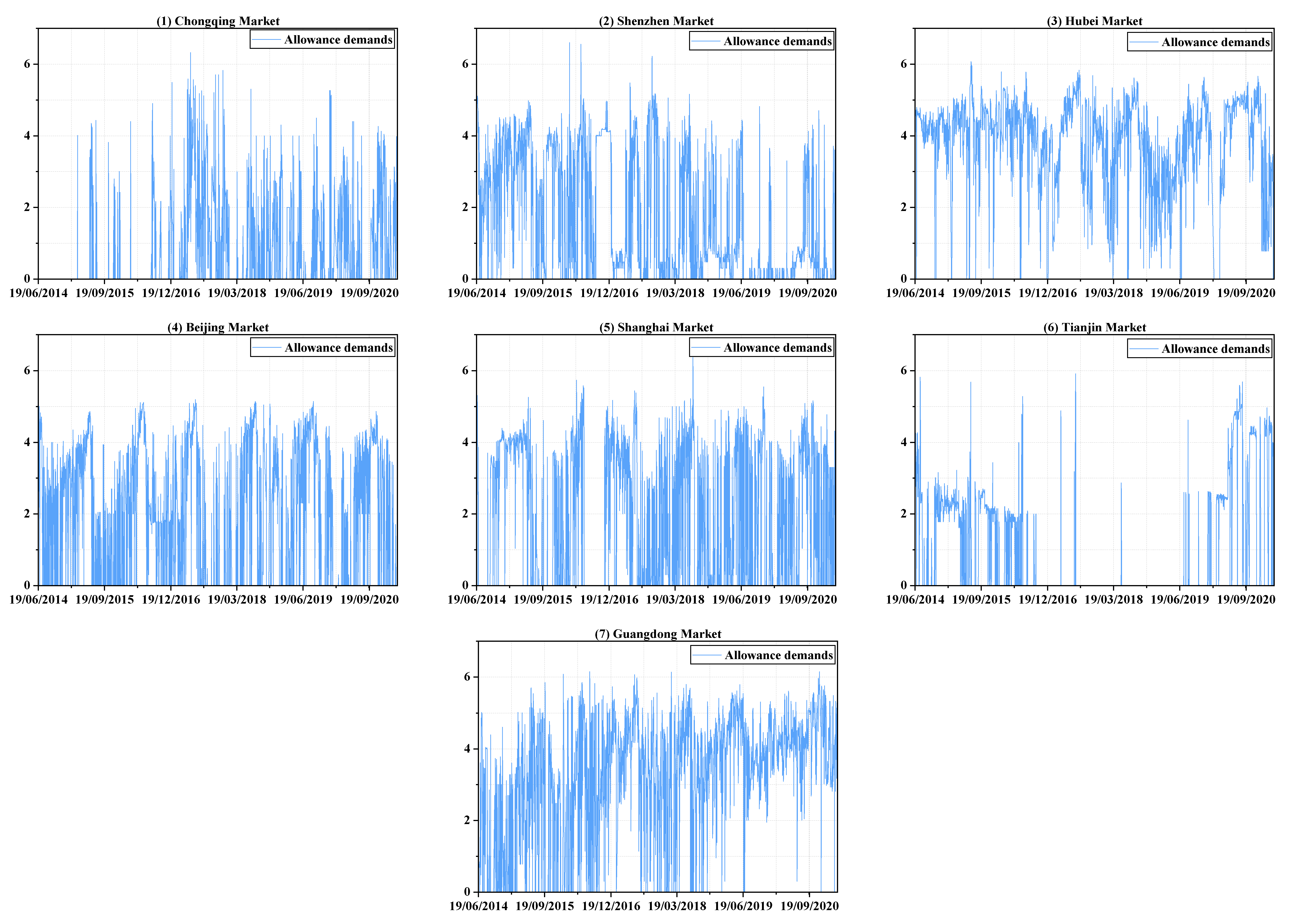
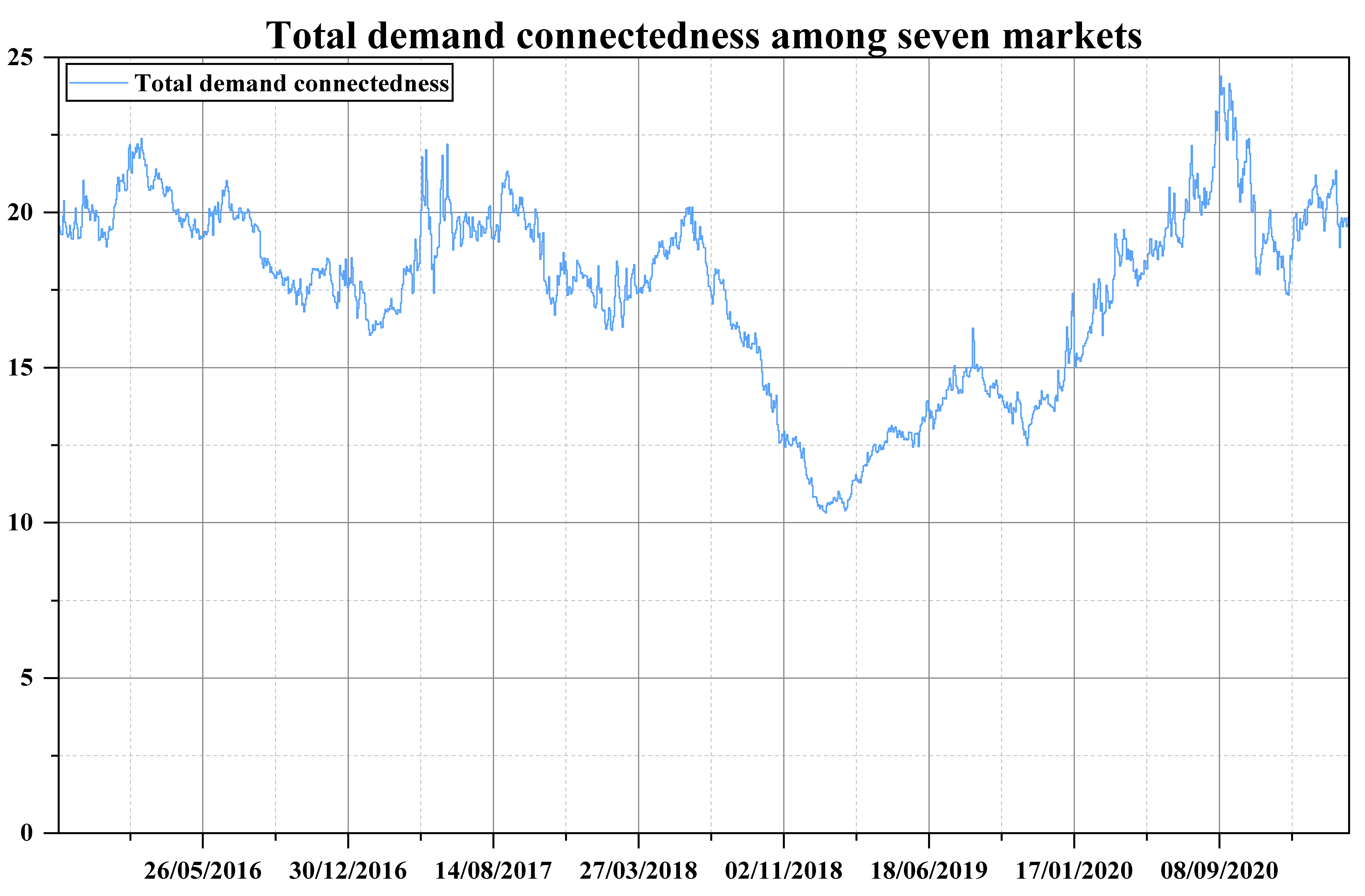
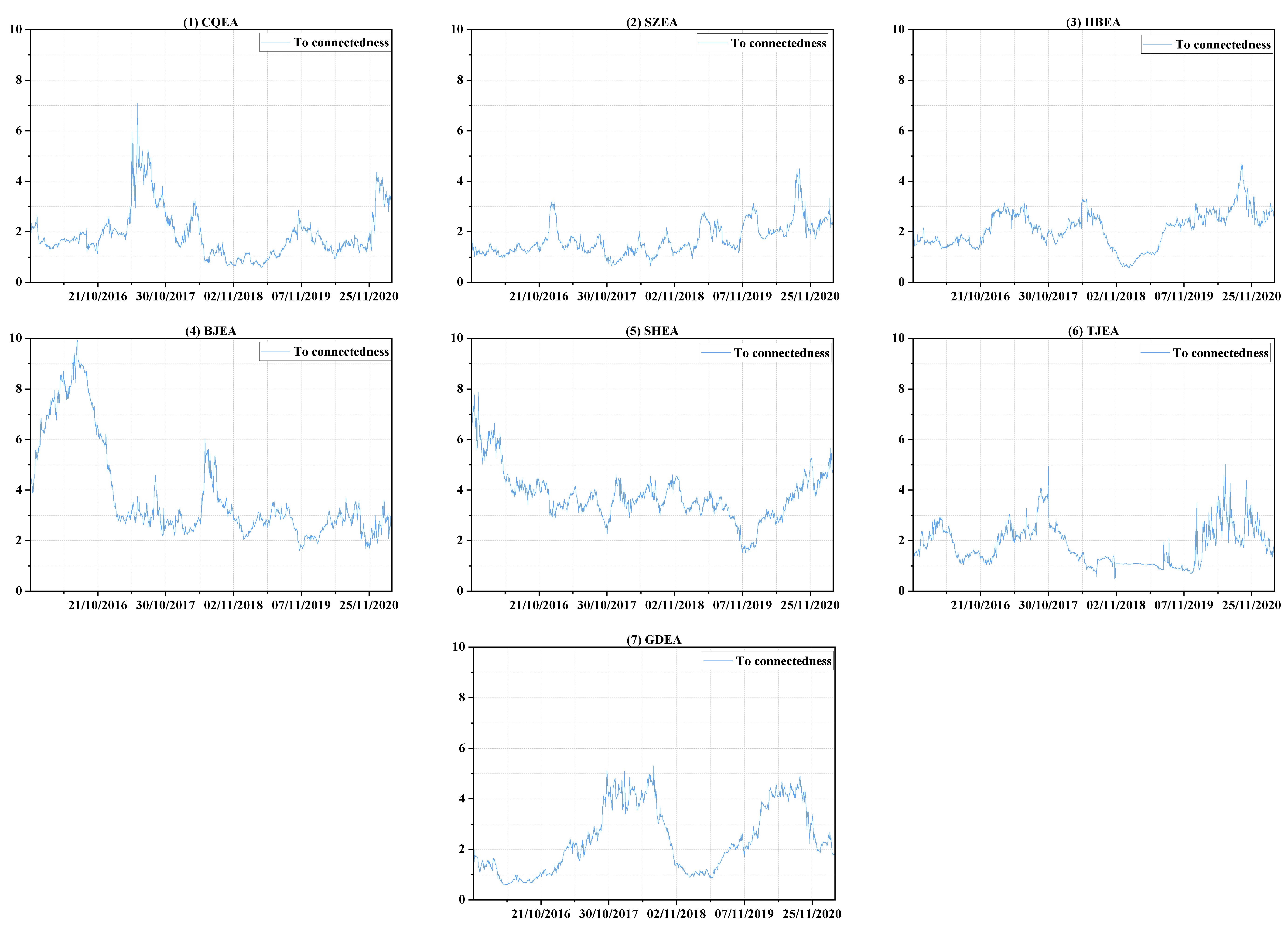
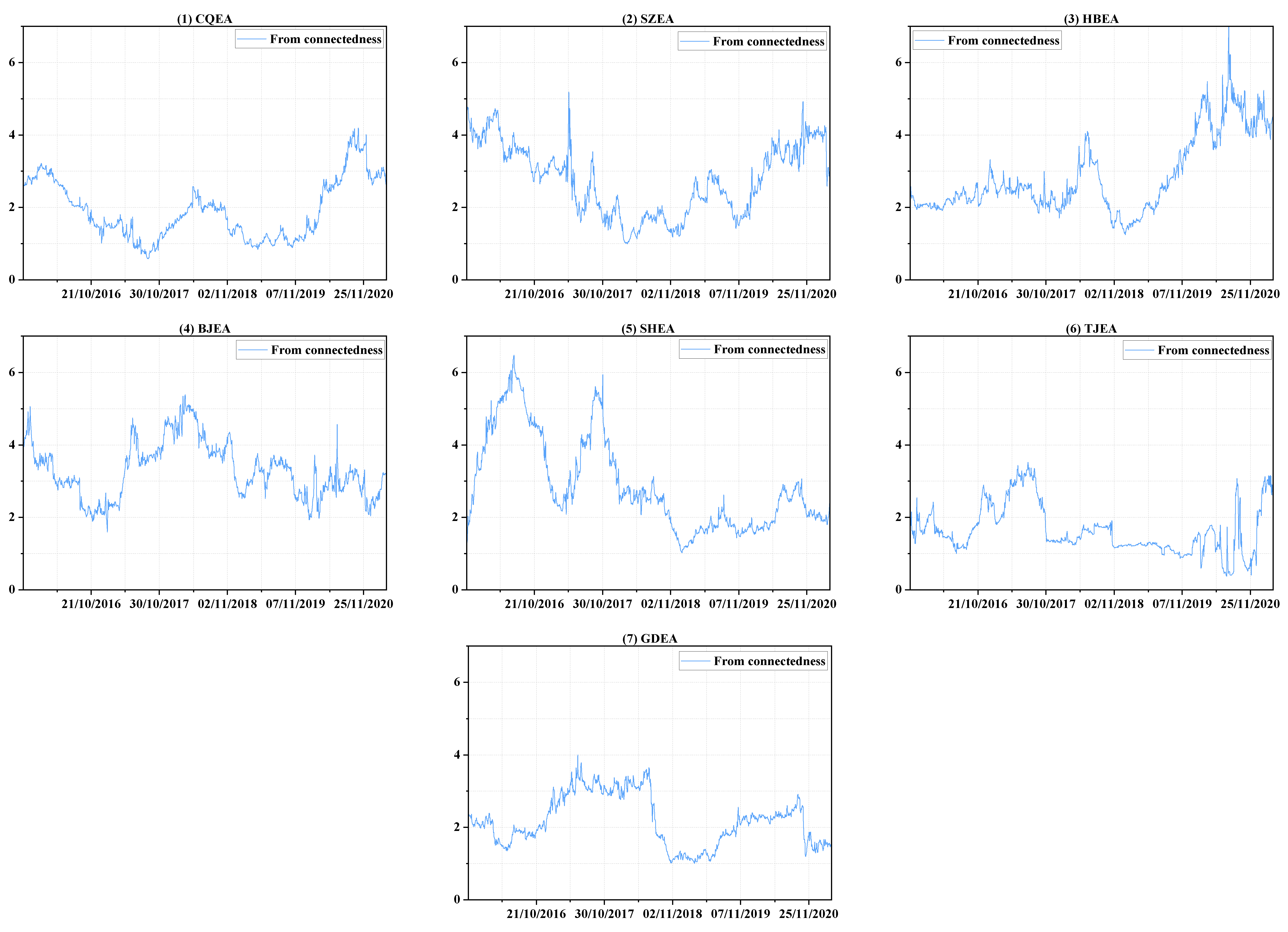


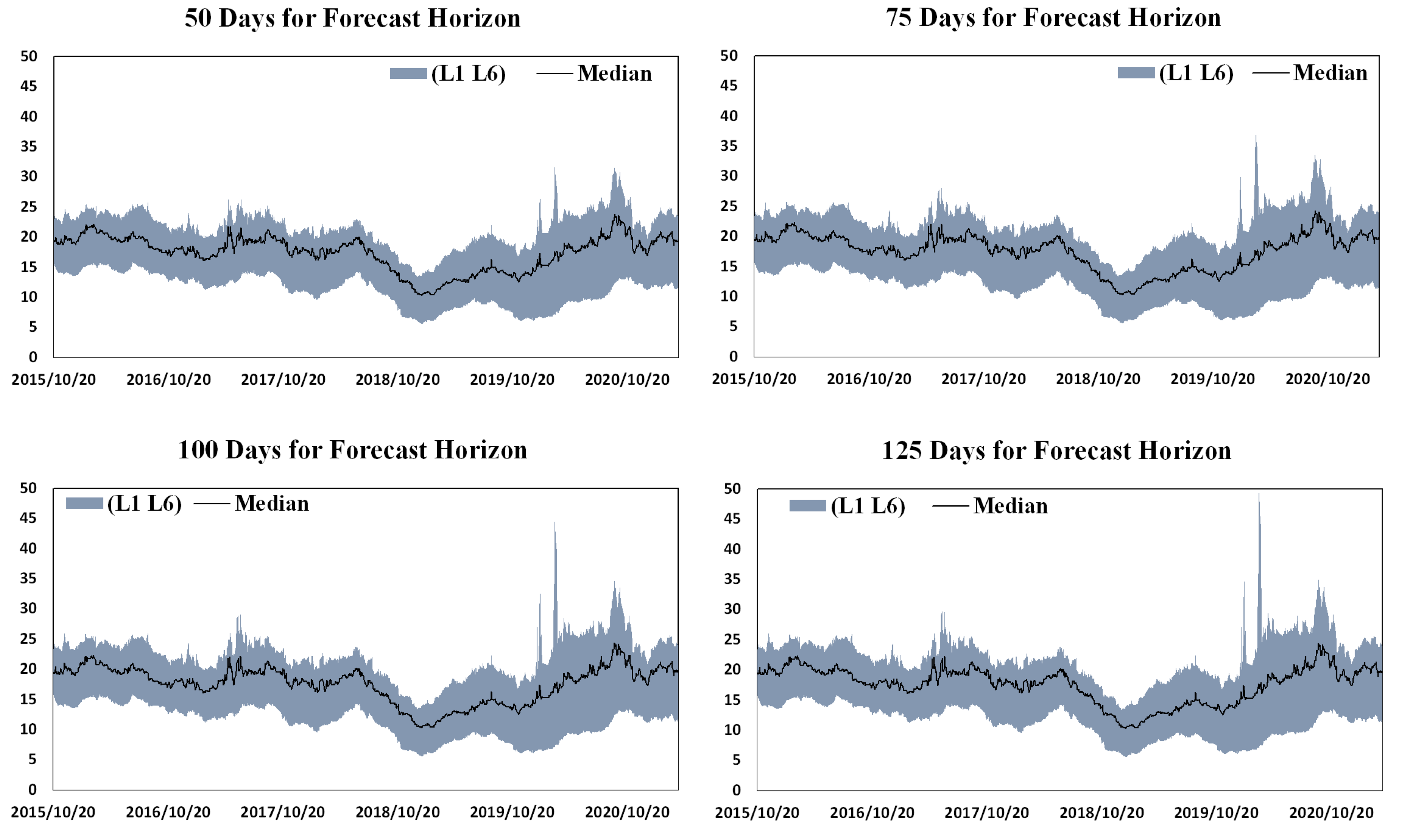
| Obs = 1663 | Mean | Max | Min | Std. Dev. | ADF(C) | ADF(T) | PP(C) | PP(T) |
|---|---|---|---|---|---|---|---|---|
| CQEA | 0.79 | 6.32 | 0 | 1.32 | 0.00 *** | 0.00 *** | 0.00 *** | 0.00 *** |
| SZEA | 1.75 | 6.60 | 0 | 1.75 | 0.00 *** | 0.00 *** | 0.00 *** | 0.00 *** |
| HBEA | 3.81 | 6.07 | 0 | 1.29 | 0.00 *** | 0.00 *** | 0.00 *** | 0.00 *** |
| BJEA | 2.02 | 5.19 | 0 | 1.84 | 0.00 *** | 0.00 *** | 0.00 *** | 0.00 *** |
| SHEA | 1.93 | 6.37 | 0 | 1.91 | 0.00 *** | 0.00 *** | 0.00 *** | 0.00 *** |
| TJEA | 0.97 | 5.92 | 0 | 1.50 | 0.00 *** | 0.00 *** | 0.00 *** | 0.00 *** |
| GDEA | 3.24 | 6.15 | 0 | 1.73 | 0.00 *** | 0.00 *** | 0.00 *** | 0.00 *** |
Publisher’s Note: MDPI stays neutral with regard to jurisdictional claims in published maps and institutional affiliations. |
© 2022 by the authors. Licensee MDPI, Basel, Switzerland. This article is an open access article distributed under the terms and conditions of the Creative Commons Attribution (CC BY) license (https://creativecommons.org/licenses/by/4.0/).
Share and Cite
Guo, L.-Y.; Feng, C. Measuring the Demand Connectedness among China’s Regional Carbon Markets. Int. J. Environ. Res. Public Health 2022, 19, 14053. https://doi.org/10.3390/ijerph192114053
Guo L-Y, Feng C. Measuring the Demand Connectedness among China’s Regional Carbon Markets. International Journal of Environmental Research and Public Health. 2022; 19(21):14053. https://doi.org/10.3390/ijerph192114053
Chicago/Turabian StyleGuo, Li-Yang, and Chao Feng. 2022. "Measuring the Demand Connectedness among China’s Regional Carbon Markets" International Journal of Environmental Research and Public Health 19, no. 21: 14053. https://doi.org/10.3390/ijerph192114053
APA StyleGuo, L.-Y., & Feng, C. (2022). Measuring the Demand Connectedness among China’s Regional Carbon Markets. International Journal of Environmental Research and Public Health, 19(21), 14053. https://doi.org/10.3390/ijerph192114053






